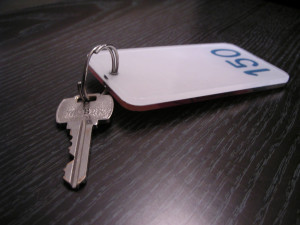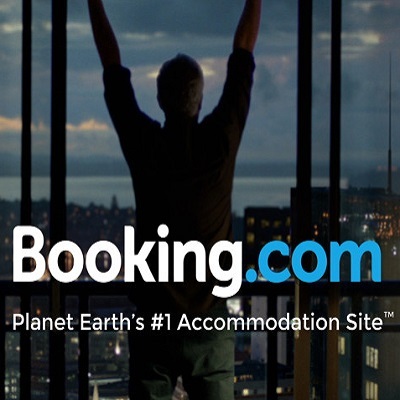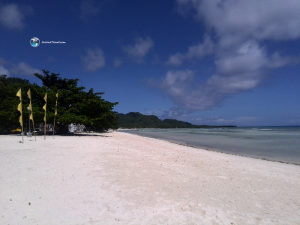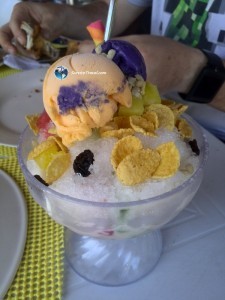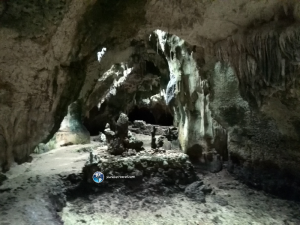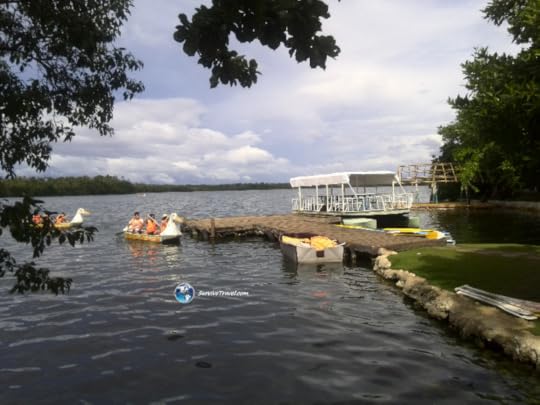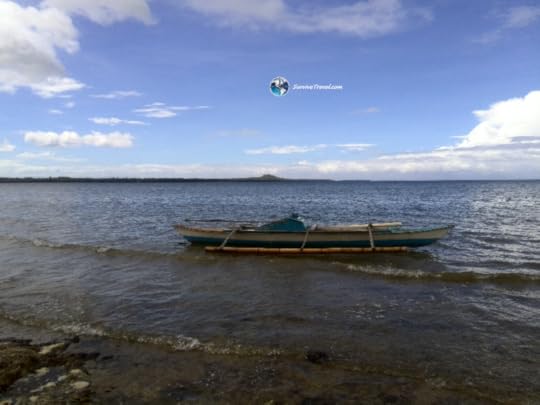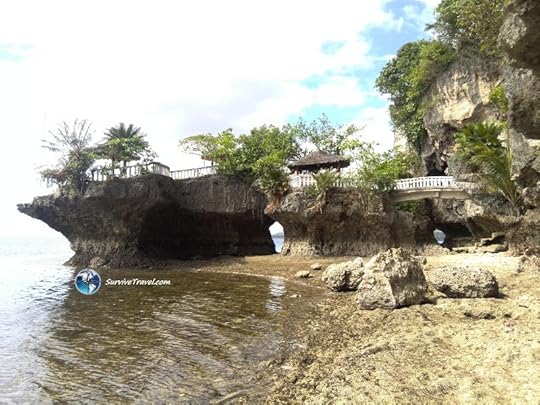Sam Fury's Blog, page 55
February 5, 2016
Desa Dairy Farm Review, Kundasang, Malaysia – Survive Travel
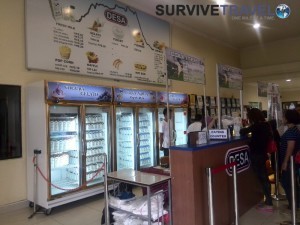
This post is a Desa Dairy Farm review.
Desa Dairy Farm is located about 2 hours drive from Kota Kinabalu in Kundasang (Sabah, Malaysia), just a bit past Mount Kinabalu park.
This Desa Dairy Farm review includes directions, pictures, costs and my personal opinions which may or may not contain useful information.
Right Picture: All sorts of dairy products for sale as well as hotdogs and pizza.
For the quick version of this Desa Dairy Farm review you can scroll to the bottom of this post and look in the reviews. Mine is the first one  .
.
Cost(s): 5MYR for adults and 4MYR for children.
Address: Kundasang, Sabah, Malaysia
Desa Dairy Farm Review, Kundasang
My Malaysian mum decided we should go to the Desa Dairy Farm to drink fresh milk and squeeze some cow teets, so we did.
Three things that stood out to me about Desa Dairy Farm are:
1. It’s cool (temperature) up there in the mountains.
2. It’s really cheap to get in, but you need a car to get there so probably not worth it for the non-driving tourist.
3. Teet squeezing is only on certain days and the day we went (Monday) was not one of them.
4. It was surprisingly busy, but that is probably due to it being the holiday season.
Things to do in Desa Dairy Farm
Buy Dairy Products
Well it’s a dairy farm so what better place to get it fresh. Yogurt, cheese, milk (cow, goat and various flavors), ice-cream as well as hot dogs, waffles and pizza. I think the pizza was only for school holidays, and they ran out when we went to order it.
There is also a souvenir shop with T-shirts, postcards alike.
Feed the Calves
There’s cows and goats in the calves section. You can go and take pictures and for 1myr you can feed them grass, or for 1.5myr you can feed them milk.

For a small fee (1-1.5 MYR) you can feed the calves.
Watch the Big Cows
Just stand and watch the big cows do their thing… which isn’t much but defecate.
They are not tied up (that I could see) but they don’t seem to want to go anywhere else. Content cows.

Watch the cows piss, sh*t and just lay around. They seem content, they are not tied up but they don’t go anywhere.
Look at the Fields.
Before you get to the main building there is a field with cows pasturing (I think that is the right word). It was a misty day for us but when it’s clear you can see Mt Kinabalu.

Out in the fields.
Watch the Cows Get Milked
From inside the building you can view the cows get milked from 1430 to 1600 daily. On certain days I think you can even have a go at milking them. Maybe check out their website for details on this.
For me the Desa Dairy Farm was okay but I do not think the 2+ hour drive was worth it. It is not like a massively impressive thing. If you happen to be driving past it is worth going in for an hour or so and getting some milk and cheese.

From 14:30 – 18:00 you can watch the cows get milked.
Want to know all the best things to do in Sabah? Get all the information on Sabah and the rest of Malaysia that you need with arguably the best travel guide books on the planet.
Getting to Desa Dairy Farm in Kundusang
We drove from Kota Kinabalu and I didn’t see any tourist buses or other way to get their. There was a minivan or two but I’m pretty sure they where privately hired. I am sure if you are going to Mt Kinabalu and you really wanted to look at the Desa Dairy Farm then you could just ask the locals and they would point you in the right direction.
Need somewhere to sleep while visiting Sabah in Malaysia? Find your perfect accommodation no matter what your budget.
Have you been to Desa Dairy Farm in Kundusang before? Help out other readers and leave your Desa Dairy Farm review below, and if you know of more or updated information or even if you just want to say hi then please leave a comment  .
.
The post Desa Dairy Farm Review, Kundasang, Malaysia – Survive Travel appeared first on Survive Travel.
February 2, 2016
3 Steps to Create a Life of Constant Travel

To be able to create a life of constant travel is not hard.
Like everything in life that you have gotten you just have to go out and get it.
This post explains how you can create a life of travel in “3” steps.
I put the number 3 in quote marks because like everything, each step has steps of their own.
Picture Right: Step 1. Get in the Right Mindset. Sourced from Pinterest.com
Featured Image: Courtesy of FreeImages.com
Create a Life of Constant Travel
Step One – Get in the Right Mindset
Having the wrong mindset, in particular the wrong paradigm (reference: 7 Habits of Highly Effective People), is what stops most people from achieving a life of constant travel, or any other goal. You need to change the way you think as well as what you do.
Know that it is Possible
Many people think that being able to create a life of constant travel is not possible. I rarely say this to people, but you are wrong! It is most definitely possible and not even that hard. I am living proof and I am not anything special. There are literally thousands of people that have created a life of constant travel for themselves.
You Are not Really Creating a Life of Constant Travel
To Create a life of constant travel doesn’t necessarily mean you have to always be on the move. It just means that you have the ability to come and go as you please. You can stay in one spot for months if you want, as I often do, but I have the ability to go at any time if I want because I have no obligations. It is creating, not necessarily implementing. It is the creating that gives the option of implementation, which is where the joy lies – at least that is true for me.
Perhaps I should have named the posts “How to Create a Life of No Obligations”, but that wouldn’t be 100% true either, because obligation lies within. You are only obligated to things because you dictate that you are obligated. I have no boss to answer to so I have no obligation of work, but if I make no money then I will starve, so I do have an obligation to myself to create income. Another example may be that I do not have a wife or children so no obligation to provide for them, but if a relative or close friend really needed my help then I would feel obligated to do so, but that is my choice.
Just a side note, having a family is not an obligation that stops the creation of a life of constant travel, in fact, it is more of a reason to do so. If you create a life of constant travel it just means you are creating time. Maybe you don’t use that time for travel, maybe you use it to spending time with your family, and here-n lies one of the big “secrets” in creating a life of travel, but more on that in step two.
Let Go
The wanting to “hold on” to things in your current life allows for many excuses.
“What about my car, my house, my job, my phone plan?” etc. If you want a life of constant travel then you must let go of these things.
Well this isn’t exactly true. You can have all the stuff you want (assuming you can afford it), just be prepared to leave it behind when you go to your next destination.
2. Fund Your Travels
Well I am not going to lie, traveling costs money. Even if you do it as cheap as possible and never pay for accommodation, travel costs, souvenirs, attractions etc (very, very possible) you still need to eat. So at the very least (unless you steal or eat out of the garbage) you need to pay for food, which can also be done very cheaply if you want.
Traveling is Not as Expensive as You Think
I am not as budget as the suggested above. You could sleep for free with couch-surfing, hitchhike everywhere and skip any tourist attractions that require entry fees etc., but I am not that sociable and like having a private bathroom, I tend not to hitchhike unless I have to and sometimes I want to see the tourist attractions. Even with all these expenses, I still spend less than I would if I was living in Australia, because I am not trying to “keep up with the Jonse’s”. Not having a car, rent, the latest phone etc. Also, I do not drink alcohol that much and like to eat local food as opposed to dining in “nice” restaurants all the time.
Set A Budget
This does not have to be complicated. No matter where I go my maximum budget is $50/day (USD). I rarely spend this much. Sometimes if I do an expensive tourist attraction or buy a plane ticket etc. it goes way over, but it evens out over the other days. Yes, I can still get private accommodation with bathroom, but I travel in cheap countries. If I was in the States, UK, Australia etc I would probably be hosteling or couch-surfing, or more likely, staying with friends.
Another thing I do sometimes is just to stay in a cheap country until I “save up” enough to go to the more expensive ones.
Anyway the point is to set a budget and stick to it as an average, so maybe track it once a week and adjust as necessary.
Raise Funds
Usually people will have their funds and then set a budget accordingly. It makes sense.

Step 2. Fund Your Travels.
Image courtesy of FreeImages.com
There are a number of ways you can fund your life of constant travel. Here are some (not all) of them.
Make lots of money and then travel
Most people work, save money, go on vacation, go back to work. You could just do this on a bigger scale. Work and save heaps of money and then travel for as long as you can. The problem with this is that unless you save up like really alot, then eventually you will have to work again, so it is a part-life of constant travel. Like a gap year but it may least a while depending on how much you saved.
Work Abroad
By this I mean you go abroad and get a job e.g. a summer camp, bar work etc. I have put his in here just to say that this is not an option. You will not be creating a life of constant travel. You are just working in another location i.e. not traveling from somewhere other than your home town. You may travel from town to town taking short contracts and travel around the general area but you do not have the ability to come and go as you please i.e. you have to show up to work, assuming you want to keep the job.
I’m not saying it is not a good way to travel. I did it for years and really enjoyed it, but it is not creating a life of constant travel, it is just working abroad.
Work Online
This includes any job you can do online such as writing, teaching, web design, photography, etc.
The problem is that any job where you are employed, whether you are working on-line or not, still means you have deadlines and things you HAVE to do in order to keep the job.
Also, you will be internet reliant to make money. Maybe not all the time e.g. you can write off-line, but it isn’t called an on-line job for nothing.
If this sounds like a path you might want to explore than the Survive Travel Paid Reviews program might be something you are interested in.
Create a Residual Income
Now this is where it is at. If you can create an income that keeps giving then you can truly live a life of constant travel.
There are many ways to create a residual income, but they all basically revolve around building a business of some kind. Even if you residual income is based solely on investing, then investing is your business.
You have two choices.
1. Build a residual income and then travel, therefore living off the residual income.
2. Build a residual income whilst traveling.
Both have the same end result.
Number one means it will take longer for you to actually start traveling but your residual income will probably grow faster.
Number two means you need something to sustain your travels while to build the income.
Step Three – Go Do It.
Once you have your plan of how to create a residual income then you have to implement it, but you don’t just implement, you have to continue do do it. Persistence is the key.

Step 3. Go do it and be persistent. Image courtesy of illuzone.net
More on Building a Residual Income
Create Time, Not Money
This is just my opinion but I find that many travelers feel the same way. It is not about creating a huge income, although it definitely has that potential, it is more about creating time.
If you create a residual income it means you do not have to work to get the income. You may have to work to increase the income, or even to sustain a certain level, but if you are happy for it to stay the same or perhaps drop slightly then you could stop working and still be okay.
Creating a residual income is also the way to create a massive income. You just compound the residual income streams, but this obviously means you need to work harder to create those streams. You should find the happy medium for yourself.
This doesn’t just apply to a life of constant travel. You can do this and then live however you want. It gives you freedom. Your are your own boss. Work on your own time.
The Option I Took – Travel Blogging
I figured that since I am traveling I should just take photos and write about my experiences. Actually it is not that simple. I also need to maintain the website, think about SEO, create income from advertisements and affiliates etc, but still, not a bad way to go.
I mentioned it before and it is not really travel blogging but if you want to make a bit of extra money whilst traveling then we will pay you for your travel related reviews.
If living a life of constant travel is something that interests you then you might want to check out How to Travel on a Budget by Aventuras De Viaje.
Well that’s is for this post on how to create a life of constant travel. Let me know your thoughts in the comments  .
.
The post 3 Steps to Create a Life of Constant Travel appeared first on Survive Travel.
January 31, 2016
3 Steps for Finding the Best Accommodation in 15 minutes
When I first started traveling I used to spend hours comparing the comparison websites finding the best accommodation deals.
Over the years I have refined the process so that I can find the best accommodation in 15 minutes.
What classifies as the best accommodation?
Well it is dependent on what you are looking for, which happens to be step one.
Finding the Best Accommodation in 15 minutes
1. Know What You Want
Facilities, budget and location are the three things to look at here. Basically just know what your criteria is.
Facilities
Factilities are those things which you want the accommodation to have. List those that are important to you, and also prioritise them so if your budget does not allow for it you can concede on a sliding scale.
I’ll use me as an example.
* I am not much of a people person and I like to work so I want a private room. This is the highest priority for me.
* If it is hot I at least want a fan, and if it is cold then heating becomes a must.
* I like to have a private bathroom too. It is not 100% necessary but if it goes with my budget then I will get it.
* Having a kettle is a big plus for me since if I really wanted to I could cook with it.
* Free internet used to be a must for me, and it is still pretty important, but these days I always get a simcard with internet which is enough to do what I need. Every now and again I can just go somewhere with wifi and work for a couple of hours to “catch up”.
* A fridge is nice but not a necessity.
* Air con, TV, toiletries etc are all just nice bonuses for me, but not really something I look for.
* I don’t care so much about free breakfast. It is a nice bonus and if everything else is the same then the one with free breakfast is a decision maker.
Budget
What is your maximum budget per night?
For me this is relative to my location. I usually go for the cheapest thing that meets my criteria. 20USD a night is usually my maximum in a non-western country.
Location
If I am coming in late I will catch a taxi, so closer to the airport (or bus station) is better. In all other circumstances I usually go for somewhere with easy access to the sites but preferably a little out of the city but still with things to do nearby i.e. a chilled bar and food.

Budget is a concern fore most people when finding the best accommodation. Image courtesy of FreeImages.com
2. Compare Your Options
This is the step that takes the longest. Go to Booking.com and search the city you want. Sort the results by price then go down the list looking at the maps and note the ones that are both in your price range and in the location you want. This should narrow things down quite a lot. Do not choose more than five. I usually just pick the cheapest three in the right location. Compare you choices and pick one.
If Booking.com does not have anything in the city you want (it may be an obscure place) then try hostelworld.com or Agoda.com. These are my three favorite accommodation comparison websites in that order, i.e., Booking.com is my favorite, then hostelworld, then agoda.
You can also consider Wikitravel.org as they usually have some good choices. Same goes for Lonely Planet guidebooks.
As a side-note, another reason I like booking.com so much is that it gives you GPS co-ordinates.
3. Book Your Accommodation
Once you have found the place you want, book it. Don’t um and ah over it and continuously re-read reviews, it’s a massive time waster. Just book the one you think is the best for your needs, but do not book it for more than a couple of nights so if you don’t like it it is no big loss. I usually don’t book anything for more than one night. If I decide I like it I just re-book it for however long I want.
Book your perfect accommodation today.
Do you have your own method in finding the best accommodation? Let us know in the comments  .
.
The post 3 Steps for Finding the Best Accommodation in 15 minutes appeared first on Survive Travel.
January 27, 2016
Six Incredibly Useful Travel Apps
I have a tonne of apps on my phone but these are the ones which I feel are the six most useful travel apps, or at least they are the ones I use the most often when traveling.
This list of incredibly useful travel apps does not include social media or other apps that I use for blogging.
Image Right: Google Play is a major player in android apps. Image sourced from Google Images.
Featured Image: Courtesy of nbcnewyork.com
Six Incredibly Useful Travel Apps
1. OSM And
This is by far the app that comes in most useful while traveling. I would literally be lost without it.
Apart from being a GPS it can also tell me where points of interest are.

Image is a screen shot from the Google Play Store.
2. Compass
Sometimes the GPS does not work, or all I want to do is find direction without having to open the gps. I also carry a real compass.

Image courtesy of FreeImages.com.
3. Booking.com
Booking.com is my go-to accommodation booking site. When it comes to actually booking I prefer to use the website, but to check current bookings the app come in very handy as it works offline.

Booking.com is my favorite accommodation booking site. Image sourced off Google Images.
4. XE Currency Converter
Great for converting currencies and works off-line as long as you have added the currencies you want to convert between into the app.

Image sourced from the website.
5. Google Translate
With google translate you can translate between almost any two languages. It is not the most accurate app there is but is good enough to get you by. If you download the language pack onto your phone then it can be used offline also.

Remember these pocket translators. Image courtesy of FreeImages.com.
6. Ankidroid
Ankidroid is a flashcard app which I use to learn languages. There are other language learning apps like duolingo (another of my favorites) but I prefer ankidroid because it can be used offline and is not as processor heavy, although I do feel that duolingo is a better way to learn than just flashcards.

Image sourced from Google Images.
Well that’s it for this list of incredibly useful travel apps. What apps do you find useful when traveling? Let us know that or anything else you want to say in the comments  .
.
The post Six Incredibly Useful Travel Apps appeared first on Survive Travel.
January 24, 2016
Danum Valley Review, Sabah, Malaysia – Survive Travel
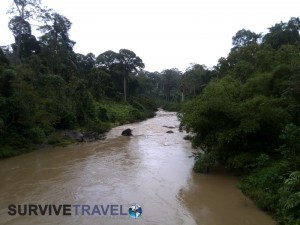
This post is a Danum Valley review.
Danum Valley is a forest reserve found in near the town of Lahad Datuk in Sabah, Malaysia.
This Danum Valley review includes directions, pictures, costs and my personal opinions which may or may not contain useful information.
Cost(s): Sorry but due to the fact that this was a family holiday I didn’t pay for anything!
Address: The entrance to the park is South of Lahad Datuk.
Danum Valley Review, Sabah
Starting a couple of years ago my Malaysian family (as opposed to my Australian one) started taking family trips which happens at least once a year. I don’t usually attend but this time I happened to be in Malaysia at the time so I went along.
Three things that stood out to me about Danum Valley are:
1. There is a lot of research and volunteering happening there.
2. I was disappointed with the lack of wildlife I saw, but I’m sure if I actually went looking for it a bit harder I would have seen more.
3. We drove there but it seems like it would be a mission for self traveler, but if you like hiking and nature then it would be totally worth it.
Things to do in Danum Valley
Night Safari
On our first night we went on the night safari. We saw a couple of flying squirrels but not much else.
While not on the night safari we saw monkeys, wild boars and deer.

This is some wild boars but we didn’t see these on the Night Safari.
Observation Towers
There are a few observation towers in the valley and a couple of them are relatively close to the accommodation. We walked past this on our way to the river but didn’t go up it as there were already people up there. We went up one for sunrise earlier in the morning.

We didn’t climb this one but did climb one earlier that morning for the sunrise.
Swimming
I know there are at least two waterfalls. We didn’t go to any of them, but we did wade in this part of the river.

The river we went swimming in.
Trekking
If there is one thing there is plenty of in Danum Valley it is trekking. Loads of trails at of varying lengths and difficulty levels.

Taken from a suspension bridge.
Accommodation
There is a number of different types of accommodation to choose from including hostel type dormitory’s, family rooms or separate challets. There is also a restaurant but doen not cook to order, i.e. you have to get it as part of a package where they prepare all meals for you. Alternatively, and what we did, was cook our own using the kitchen in the hostel.
Mount Silam
Although not really in the Danum Valley I feel this was worth a mention. You have to drive up but at the top there are some treks you can do. It is actually quite well maintained but very few visitors.

Mount Silam isn’t in the Danum Valley but you pass it on the way.
I am a nature lover so I would definitely recommend going to Danum Valley, even if it is a bit of a mission to get to. The nice thing is that it is not that tourist friendly so it is not crowded. This is when I compare it to other national parks I’ve been to like Plitvace in Croatia.
Want to know all the best things to do in Sabah? Get all the information on Sabah and the rest of Malaysia that you need with arguably the best travel guide books on the planet.
Getting to Danum Valley in Sabah
We drove from Kota Kinabalu and stopped for a night in Tawau. Without the stop it would be at least an 8 hour drive.
I talked to an English bloke in there and he said he found his own way to Lahad Datuk and then the Danum Valley shuttle bus picked him up and brought him in. I guess this is one of those places you have to call ahead otherwise not only would you not have a ride in but you wouldn’t have anywhere to sleep or anything to eat.
Need somewhere to sleep while visiting Sabah in Malaysia? Find your perfect accommodation no matter what your budget.
Have you been to Danum Valley in Lahad Datu before? Help out other readers and leave your Danum Valley review below, and if you know of more or updated information or even if you just want to say hi then please leave a comment  .
.
The post Danum Valley Review, Sabah, Malaysia – Survive Travel appeared first on Survive Travel.
January 11, 2016
The Best Way to Transfer Money Overseas

Discover the best way to transfer money overseas.
This post compares some of the most common ways to transfer money between countries and also gives my opinions/recommendations on the best way to do it.
I’ve gone over this before but I like to refine things to save time. Not everything I do saves money, but if it saves time I count it. If I figure the time saved is worth more than the actual dollar value.
Four Ways to Transfer Money Overseas
Here are four of (arguably) the most common ways to transfer money overseas.
1. Bank Transfer
Let’s start with the most obvious way to transfer money overseas, and in my opinion, the worst way to do it.
I would never transfer money using a bank unless you are with a bank that does it for no or a low fee. Most charge at least $15, and that is on both ends!
If you have a global bank they may do free international transfers (such as Citibank or HSBC) but I delved into this and to open the bank account in another location you need to have a high balance (I think it was HSBC and/or Citibank that wanted $50, 000!) or pay a high monthly fee. If you are a high roller then this is great, but for the rest of us common travelers it is not worth it, or even feasible, which is why it is not the best way to transfer money overseas.
2. Debit Card
Now after just slagging off the bank I’m going to do a 180 and say that using banks is the best way to transfer money overseas, but in the way of debit card transactions as opposed to a bank to bank transfer, and in a way that endures the least amount of fees.
When you withdraw money overseas you usually have to pay three types of fees.
1. Your banks fees for withdrawing using a non-partnered ATM.
2. A foreign exchange fee.
3. The fee from the ATM because your card is not with their bank.
Now all of these can be avoided but not always at the same time. Here’s how.
For number one and three you will need to use a partnered ATM. Many major banks have partner banks in other countries, you just need to do the research. International banks, like Citibank, will have many of their own branches.
The fees from number two can be avoided by choosing a bank that will not charge a foreign exchange fee.
There are a few awesome banks if your a US resident (such as Fidelity) who not only waive the foreign transaction fee but will also refund any ATM regardless of what bank charges them. Unfortunately you need to be a US resident, which I am not.
I don’t know about other countries but if you’re Australian the way to go is the global corporation of Citibank, which I was already a member of although a few years ago I stopped using them since they are one of those Global corporation that pretty much control the rat race side of the world.. but that’s not my world anymore so f*k it I thought, I’ll use it to my advantage.
Citibank waives the foreign transaction fee and has many atm’s worldwide so if you use one of them then you will get no fee. If you use a non-partnered ATM then Citibank will not charge you a fee, but the ATM might.
The other way to avoid the ATM fee is to pay by card in a shop, and then possible get cash out at the same time.
When you just need to get cash out in a different country, assuming you can avoid the fees, then withdrawing from an ATM or “in shop” is the best way because the exchange rate is usually quite good in comparison to exchanging cash.
Tranzfers
Withdrawing by debit is the best way to get out cash in relatively small amounts, but for anything more you should do a “bank transfer”. Not only is it safer (no-one wants to carry around loads of cash) but atm’s usually have a fairly low limit withdrawal limit (as low as 200US in the Philippines).
As I said before a straight up bank transfer is not a very good way to go, but using a company like Tranzfers.com lowers the transaction fee to approximately $5usd no matter how large teh transaction is.
Tranzfers.com is like a “middle man” company which saves you on bank fees when transfering money. It works because you only transfer into local accounts, which in most cases means a lower bank fee than if transferring internationally. Here’s an example.
Let’s say I want to transfer money from America to Australia. Bank of America (BOA) charges $25usd for an international transfer. My Australian banks do not charge me for the incoming money, but many do.
BOA only charges $3 for a domestic transfer. Tranzfers.com has bank accounts all over the world. So I transfer domestically to their bank in the US, then they transfer it internationally to their bank in Australia, which then gets transfered domestically into my bank. I guess they make such large transfers every day that it nullifies the transaction fee.
Tranzfers charges a flat fee no matter how much you are transferring. It differs depending on the currency, but is generally around $5usd.
So no matter how much I transfer between BOA and my account in Australia I will be charged $8.00, and on my birthday Tranzfers gives me one fee-free transfer if I use it within a month, which is better than a kick in the nuts.
There are a lot of companies that do a similar thing to Tranzfers but I like these guys the best. It is a low fee, they are reliable (I’ve been using them for years) and they do all the popular currencies. It is a very good runner for being the best way to transfer money overseas.
Paypal
It costs me 1% to transfer money using Paypal, so if I am transfering under $800 USD I will use them, otherwise I will use Tranzfers. Why $800? Because it costs me $8 to transfer with Tranzfers. $8 is 1% of $800. The maths may be different depending on how much your bank fees are.
Now to do this with Paypal means you need to have a Paypal account in both the countries you want to transfer between and Paypal is forever increasing regulations so I’m not sure how easy this is now days. Even when I did it 8 years ago I think it was a little troublesome.
Another problem with Paypal is the security. It’s too good. I often get blocked out if trying to log in from another country. The way around this is to create a travel plan, but even this sometimes doesn’t solve the problem, and in general, I think Paypal’s customer service is sh*t. Four out of five times my problems don’t get solved or I get disconnected or given the run-around etc.
Bottom line with Paypal is that when it works its great. An easy process to transfer money and also has many other uses. You could in fact use Paypal like a bank account assuming you run a business where customers can pay you via Paypal. They can even give you a credit card!
Another big advantage Paypal has over Tranzfers is that it is much faster. From Paypal to Paypal is instant and then you just need to wait to withdraw the money into you bank, which I have found is under 48 hours, many times within 24 hours. Tranzfers on the other hand takes about a week since you have to wait for two transfer times.
Paypal is a good way to do international transfers, but I would not consider it the best way to transfer money overseas.

Best Way to Transfer Money Overseas – Conclusion
As I said at the start of this post not everything I do is to save money. A lot of it is just about efficiency and it is for this reason that I feel that Tranzfers is the best way to transfer money overseas and I use them all the time. If the money I need to tranzfer is under $800usd I just “roll it over” to the next month so it is more. Now this takes longer for the transfer but is less “mucking around” to do the actual transfer unlike Paypal where I am often blocked out because I am traveling.
Tranzfer money overseas the smart way today with Tranzfers.com!
What do you think is the best way to transfer money overseas? Let us know that or anything else you want in the comments  .
.
The post The Best Way to Transfer Money Overseas appeared first on Survive Travel.
January 8, 2016
28 Day Philippines Itinerary – Survive Travel
This post is summary of a 28 day Philippines itinerary.
It starts in Moalboal and ends in Cebu City. Well actually it starts in Cebu City and ends in Manila but the first and last days are just because I flew in and out of those two cities.
Being Australian I can enter the Philippines for 30 days visa free. I spent the first 2 weeks in Moalboal learning Filipino Martial Arts and also did a dive course. During the second two weeks I did some sightseeing around the Visayas before catching my flight from Manila back to Malaysia.
I decided to bypass Palawan on this trip so I am not rushed. I will do Palawan and North of Manila when I go back in February.
28 Day Philippines Itinerary
Links will direct you to item specific posts.
7th November
Arrive Cebu.
Sleep in La Maria Pension Hotel
8th November – 21st November
Bus from Cebu City to Moalboal
Filipino Martial Arts Course
Scuba Diving Course
Sleep in Vivian’s Nippa Hut
Explore Moalboal
Kawasan Waterfalls
Lambug Beach
Cangkalanog Falls
White Beach
22nd November
Moalboal to Siquijor
Sleep in Das Traum Guest House
23rd November
Explore Siquijor
Cambugahay Falls
Salagdoong Beach
Sleep in Das Traum Guest House
24th November
Siquijor to Tagbilaran
Sleep Constrell Pension House
25th November
Tagbilaran to Tubigon
Sleep TMR Pension House
26th November
Chocolate Hills
Anda Beach
Kawasan Falls
Sleep TMR Pension House
27th November
Bohol to Camotes
Sleep Bella Vista Beach Resort
28th November
Explore Camotes
Bukilat Cave
Lake Danao
Mactang Beach
Buho Rock
Sleep Bella Vista Beach Resort
29th November
Camotes to Cebu City
Sleep Mayflower Inn
30th November
Cebu City
1st December
Cebu City
2nd December
Fly back to Kota Kinabalu
I really enjoyed this 28 day Philippines itinerary and am really looking forward to going back there in February. Actually, I think even that won’t be enough so I will probably end up back there again for a third, fourth or even fifth time. I am even considering just living there for a year or two, perhaps after my India trip, although I have a feeling I might get stuck there for a while also 
January 5, 2016
20 Delicious Filipino Foods – Survive Travel
Discover 20 delicious Filipino foods including pictures, costs and other useful information as well as some (perhaps not so useful) personal ranting.
I didn’t bother with putting individual costs in this post because Filipino foods, like everything in the Philippines is really cheap. Even eating in a “tourist bar” I never paid more than $5usd for a meal, and in local places it was more like $2.
As far as Asian cuisine goes I found Filipino foods to be quite bland in comparison. Of course this is comparing to countries like China, Thailand, Vietnam, Malaysia and other places that are famous for their food.
Although Filipino food does not quite have the fame of these countries it still pretty good and help a few surprises.
20 Delicious Filipino Foods
1. Silog
There are a whole bunch of dishes with silog at the end, so I figure Silog is the way it is cooked… shallow fried I’m guessing. It is basically rice, egg and whatever type of meat you choose. It tastes nice, especially when they put some garlic in the rice, but I don’t like that it has no vegetables.

Tapsilog – Tapa (pork I think), egg and rice – 68php
2. Guisado / Afritada
These are two seperate dishes but I put them together because they are basically the same. The only difference is that one of them has beans and the other doesn’t – at least that is what the waitress told me. I can’t be sure which is which, but I feel like Guisado is the one with beans.
Basically it it meat and vegetables (or purely vegetables if you choose) in a tomato-based sauce. It is pretty good.

Guisado
3. Jackfruit
I didn’t recognise this as Jackfruit but I posted it on Instagram and someone said that’s what it was, so there you go.

Jackfruit
It’s an interesting fruit. I found it hard to eat but that is probably just because I don’t know how. I eneded up just cutting it in half and digging in on the flesh. The tastes is pretty good. Sweet but not as sweet as mangostein. Also has hints of sour. It has many seeds inside, so you basically suck the flesh off the seeds.
I wouldn’t get it again, just because it is cumbersome to eat, but I enjoyed the taste.

Tastes nice but cumbersome to eat.
Other fruits I saw a lot of are fairly common in tropical Asia including a few of my favorites like mangostein, mangoes and bananas.
4. Roadside Eatery
There are these little roadside eateries all over the place. It is basically home cooking. It tastes good and is cheap.
They have a little stall with several dishes and you just choose what you want. They’ll offer a side of rice and will usually ask you how many you want. I guess a lot of Filipinos would get two or more serves of rice. Of course you can opt for none.
I liked this a lot because it is authentic home-style Filipino cooking and you can just choose. The three dishes below cost a total of 75psp, which is about $1.50usd.

All the above for 75php, which is about $1.50usd.
5. Chicken Curry
Since discovery the awesomeness of roadside eateries I ended up eating at one for pretty much every meal so the next few things are typical dishes from these types of eateries, start with this one, curry.

Not spicy but very tasty.
6. Dumpling
The roadside eateries often have some kind of Chinese style dumpling fair. This picture gives no justice because this was the best dumpling I have very had, and after living in China for three years I’ve had a lot. That’s chilli on top… winner winner, dumpling dinner… YUM!

After living in China I’ve had my fair share of dumplings… this is up there with the best of them! It’s Filipino name is Siu Mai.
Spring rolls (meat only) were another Filipino foods “dumpling” item which I saw pretty often. They are often referred to as Shanghai Rolls.
7. Mixed Vegetables
Pumpkin, beans, eggplant (aubergine) and perhaps something else. I think it is roasted or perhaps just stewed a little. Vegetables isn’t high on the Filipino dieat but this vegetable mix was common. Bitter gourd was another that I saw often but I dislike it.

Mixed Veg – Top left of this picture.
8. Pork and Vegetables
I’m sure all these small dishes have their own names but I’m just calling it how I see it. This is the last of the common roadside items I will “feature” but others I had a go at were fish, shrimp cakes and various types of noodles.

Pork and Vegetables – Top left of this picture.
9. Boho Juice
On the trail to Kawasan Falls in Moalboal there is this guy selling Boho Juice for 5php. It came in a little plastic bag and was nice. I’m pretty sure it is just coconut milk.

Boho Juice a.k.a. sweetened coconut milk.
10. Noodles
This dish had a word preceding “Noodles”, but I can’t remember what it was. Anyway, it was pretty much stir fried glass noodles. Although vegetables are not a big ticket item in Filipino food I did find that green beans seemed to make an appearance fairly often. I am not a fan of the taste of green beans but it was still pretty good.

This is just one type of noodles found in the Philippines.
Want to know all the best places to eat in the Philippines? Find out that and what-ever toher information on the Philippines you need with arguably the best travel guide books on the planet.
11. Mungbean Soup
When I was told this was mungbean soup I was expecting it to be sweet but to my delight it was savoury. I ended up seeing this dish quite a lot in the small food stalls. I think it is popular for breakfast.

Mungbean soup in the Philippines is savoury unlike some other Asian countries where they sweeten it.
12. Halo Halo
When I was working in China one of my colleges/friend went to the Philippines. Upon his return he said I had to try Halo Halo. What he described to me was similar to ABC (I don’t know what it stands for) in Malaysia or “Cold Porridge” in China. All these dishes are pretty similar but do have there differences.

At first taste it was pretty plain… just shaved ice, but then I figured out you have to mix it all together. The first image in this post is the “before” picture.
13. Siu Pao
This is just Bao Zi (Chinese steamed buns) but in classic Filipino style it is very meat heavy.

Siu Pao = Bao Zi – Chinese Steamed Bun with meat inside.
14. Banana Chips
Unlike everything else on this list of delicious Filipino foods I only saw this item once, not to say it is not common. I feel like every market place would have them if you were on the look-out.
I bought it off some guy in the street for 10php.

Dried Banana Chips with sugar on top. Don’t leave them out cause the ants will get’em!
15. Jack-fruit Coconut Soup
This is a dish I haven’t come across before anywhere else in the world and when I was told the ingredients it seemed an odd mix, but tasted not too bad.

The lady at the stall insisted I have it.. though she didn’t have to try very hard.
16. BBQ
BBQ is popular in the Philippines. In Cebu City there is a whole food court and every single place just sells BBQ. Unlike Chinese BBQ there is no vegetables. It is all meat!

Outside my accommodation in Talibon, Bohol.
17. Sugar Coated Banana
I had no idea what these Filipino foods were when I bought it and I thought I bought two different items. Turns out they are all the same thing. Tasted fine though so wasn’t unhappy about the purchase.

Basically a banana on a stick covered in sugar. It’s still healthy right?
18. Roasted Chicken
There is this roasted chicken franchise in even the smallest towns. I never got chicken from it but it did smell good and was pretty popular with the locals.
They are not the only place to get roasted (or fried) chicken. It’s everywhere.

A roasted chicken chain store.
19. Coconut Vegetable Soup
I actually ate this the same day I had the Jack Fruit coconut soup. It was nice.

Beans, squash and some other vegetables in a coconut soup.
20. Pinoy Breakfast
I got this from my hotel in Cebu City. Not the first time I had eaten a Pinoy Breakfast. It is basically rice, eggs and your choice of a variety of meats depending on what they had, e.g., hot dog, chorizo, ham, bacon, just to name a few.

Pinoy Breakfast
Love Filipino food? Try cooking your own with these authentic Filipino recipes.
Do you know of any other delicious Filipino foods that should be on this list? We’d love to hear about them or anything else you want to say in the comments  .
.
The post 20 Delicious Filipino Foods – Survive Travel appeared first on Survive Travel.
January 2, 2016
Mayflower Inn Review, Cebu City, Philippines – Survive Travel
This post is a Mayflower Inn review.
The Mayflower Inn is found in Cebu City, Philippines, about four blocks North of Fuente Osmena Circle.
This Mayflower Inn review includes directions, pictures, costs and my personal rants which may or may not contain useful information.
Picture Right: Bedroom.
Cost: I booked the cheapest room at 850php/night.
Address: Villalon Drive, East Capitol Site, Cebu CIty, 6000 Cebu City, Philippines
Mayflower Inn Review, Cebu City
Staff
As in most places in the Philippines the staff were nice.
Size
The room was a good size, although I think they gave me a twin instead of a single. Perhaps the single room is just a twin but you only allowed one person.
Bed
Comfortable and with extra pillows in the cupboard.
Bathroom
First hot shower I had in a while, but could only either get it really hot or not at all. Still bearable through.
Everything worked as it should with flushing toilet etc.

Had my first hot shower in a few weeks in this bathroom.
Amenities
Good study desk, pretty happy with that.
Small TV with cable and okay wifi.

Study Desk and small TV with cable.
Air-conditioner that worked pretty well, although I prefer fans.
They have a restaurant downstairs. I had breakfast there which was nice. It wasn’t free but reasonably priced.

Dining Hall.
They have a nice small garden out the back, with a small but working waterfall and Coy pond. When I went out there I think the guy turned the waterfall on just for me. He seemed happy about it. I was too. I think one day I would like something similar… it was small but very peaceful.

Garden with small waterfall.
One gripe. I needed to make an outgoing call but couldn’t do it directly from the telephone in the room. I called reception and they said they would connect me. No call back. So I called them back to ask what happened. They said there was no answer but they would try again. Again no call back.
Even if there is no answer, why not tell me? And it wasn’t just that one employee because I tried again in the morning and they did the same thing. Weird. I ended up just using skype but even that was bad cause the wifi is only good sometimes.
Location
Decent location. Not too far from the main circle (walkable). Food options all around along with massage, fruit stands etc.

View from my window was not great but at least the windows opened for some “fresh” city air.
If I ever go back to Cebu City I will probably stay at the Mayflower Inn again. I looked at another place which had the same price and a bit closer to the Fuente Osmena Circle but the room was nowhere near as nice.
Book your stay at the Mayflower Inn in Cebu City.
Getting to the Mayflower Inn
I just caught a cab. Taxi’s are cheap enough in the Philippines that unless public transport is obvious or long distance then it is not worth the hassle to save a couple of buck.
Of course I imagine figuring out public transport to Fuente Osmena Circle is probably not too much of a hassle and then from there you can just walk.
Get all the information on the Philippines you need with arguably the best travel guide books on the planet.
Have you been to the Mayflower Inn in Cebu City before? Help out other readers and leave your Mayflower Inn review below, and if you know of more or updated information or even if you just want to say hi then please leave a comment  .
.
The post Mayflower Inn Review, Cebu City, Philippines – Survive Travel appeared first on Survive Travel.
December 30, 2015
5 Things to do in Camotes Islands, Philippines – Survive Travel
Discover 5 things to do in the Camotes Islands.
The Camotes Islands are a set of three small islands in the Philippines.
This overview of things to do in the Camotes Islands gives a short review of each things as well as links to more detailed reviews of individual items which will include directions, pictures and other useful information.
Right Picture – Bukilat Cave
Things to do in the Camotes Islands
1. Bukilat Cave
I didn’t feel that Bukilat cave was worth going out of the way for, but if you are going that way anyway stop in for a look.
2. Lake Danao
I was unimpressed by this, especially since it seemed to be the thing everyone said check out.
3. Mactang Beach
I just happen to come across Mactang Beach so thought to check it out. It was okay. Nothing on Santiago Bay though (#5).
4. Buho Rock
When I first approached Buho Rock I was not impressed but after a few minutes I changed my mind. A nice tranquil place.
5. Santiago Bay
My accommodation was right on Santigo Bay. It’s a lovely looking beach and probably nice to swim in during high tide (can you believe I didn’t go in! I had a toothache, although the salt water probably would have helped.)
Get all the information on the Philippines you need with arguably the best travel guide books on the planet.
Getting To Camotes
I wrote a whole post on getting to Camotes from Bohol. To do so you have to pass through Cebu City, so even if going from Bohol isn’t relevant to you the post still will be as most people will need to get to Cebu City to get to Camotes Islands.
Need somewhere to sleep while visiting Camotes Islands in the Philippines? Find your perfect accommodation no matter what your budget.
Have you been to the Camotes Islands before? Help out other readers and leave your tips on things to do in the Camotes Islands (or anything else you want to say) in the comments  .
.
The post 5 Things to do in Camotes Islands, Philippines – Survive Travel appeared first on Survive Travel.

